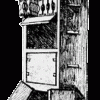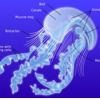Inner Nature: Rock honeybee encounter in Chennai, India

By Vidya Rajan, Columnist, The Times
I am currently in India. My father lives in Chennai, a city on the southeast Bay of Bengal coast, in a flat (apartment) in a tower block. Recently a swarm of honeybees showed up and settled on a large waterpipe that ran above a public stairwell. Anxious that passersby would get stung, a decision was made by the maintenance crew to call in pest control. A previous...
Inner Nature: Shapes of animal bodies

By Vidya Rajan, Columnist, The Times
The study of animal form and function is both illuminating and fascinating, panning from simple to complex forms. The morphing started 750-odd million years ago. At this time, the Earth was not young by any means! It was already about 3.5 billion years old (80% of its age today, which is about 4.3 billion years old) and populated by cyanobacterial mats, and single-celled...
Inner Nature: Inosculation

By Vidya Rajan, Columnist, The Times
I was taking a walk the other day (in a tropical country) and came across limbs from two trees that had twisted around each other and had actually grown into each other, presumably sharing their vasculature at the point of contact. These kisses are termed inosculation. It happens when the bark between the abutted limbs wears away due to friction and the vascular...
Inner Nature: A chat with ChatGPT about bioelectricity

By Vidya Rajan, Columnist, The Times
The power of a good story is that has sound grounding in fact, but also pushes the boundary of belief. Is it too much to imagine that our world will be un-livable soon due to the effects of climate change? Will watching the movie The Day After Tomorrow change your mind? Will watching GAATACA sensitize you to the possible outcomes of human genetic engineering? Will...
Inner Nature: Beekeeping in Ukraine

By Vidya Rajan, Columnist, The Times
“History is all explained by geography.” Robert Penn Warren, novelist and poet (24 Apr 1905-1989)
In this article, I want to pay homage to Ukraine’s beekeepers and beekeeping in light of the many wars that have washed over this beleaguered land. With a land area only slightly smaller than the state of Texas, it lies at many junctions: between Europe...
Inner Nature: Palynology

By Vidya Rajan, Columnist, The Times
Palynology is the study of tiny particles such as pollen, spores, dust and soil particles, microfossils, and other miniature items that are carried as inclusions in macro items such as rock layers, soil on a shoe, paint on a wall, and foodstuffs such as honey. The presence of pollen in honey provides a clue to the flowers from which bees obtain nectar, and is a...
Inner Nature: Invertebrate mouths

By Vidya Rajan, Columnist, The Times
I have always been fascinated by mouths and the teeth and tongues that lie inside them. Mouths are both structurally amazing and functionally diverse. We eat with our mouths, use it to communicate with sounds, express emotions, and also with breathing functions. Mouths contain tongues, one of the softest, strongest, and most sensitive muscles in our body, but they...
Inner Nature: Gender and Stereotypes

By Vidya Rajan, Columnist, The Times
Human behavior is not completely governed by biological sex. People experience a remarkable natural degree of behavioral freedom which, however, is held in check by the expectations of society. Without comparable societal structures, to what degree do other animal species experience sex-based roles? Are sex-based roles in nature invariable, interchangeable, or nonexistent?
To...
Inner Nature: Feats of strength

By Vidya Rajan, Columnist, The Times
As the weather warms, we watch bees collecting and hauling fat baskets of pollen back to their hives. Bumblebees, with their improbably large bodies hover on whirring, buzzing wings that seem barely adequate to the purpose of elevating, never mind transporting their bulk. Ants swarm kitchen counters and picnics and carry away remarkably large portions of bounty...
Inner Nature: Sodium and Potassium — The Yin and the Yang

By Vidya Rajan, Columnist, The Times
In previous articles, I have examined the various roles that oxygen and iron play in living organisms. These elements are linked in an energy-cycling relationship – iron moves oxygen and electrons around the body, as well as around the inside of the cell itself to harvest energy from food [1]. In this article, I will examine another dynamic relationship: that...




